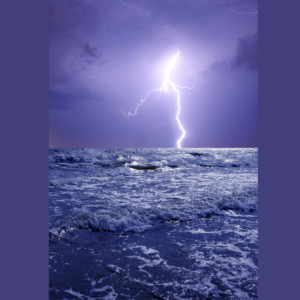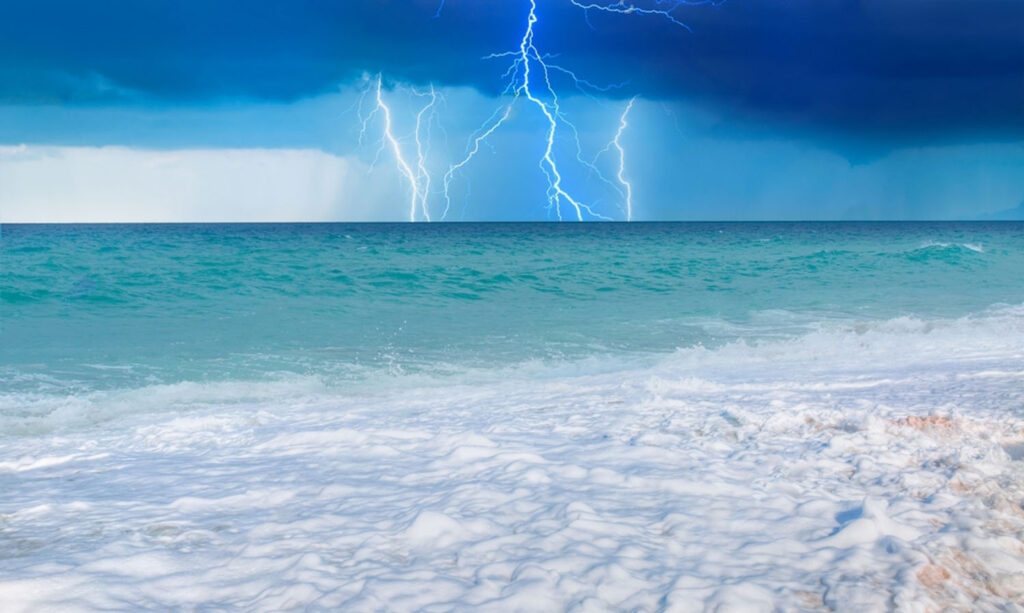Lightning Dangers at the Beach
A young man named Jack – who loved to go surfing – lived near the beach and spent most of his free time in the ocean, riding the waves.
Jack went out on his surfboard, enjoying the thrill of the waves and the beautiful, sunny weather.
But he noticed that the skies had quickly turned dark and stormy-looking. Jack decided to catch just one more wave, and paddled out.
As he was trying to catch the perfect wave, Jack felt a strange sensation in his body. It felt as if his skin was prickling with energy. Suddenly, a bolt of lightning struck the water next to him. Jack felt a sharp jolt of pain and was knocked off his surfboard.
Under the water, Jack felt his body convulsing from the electrical shock. He fought to reach the surface, struggling to breathe as the waves tossed him around. When he finally broke the surface, he felt dizzy and disoriented. He could see the storm clouds overhead, and knew he needed to get to the shore as quickly as possible.
Using a great deal of effort, Jack swam back to the beach. He felt weak and was shaking from the shock, and he could feel burns on his skin.
I’ll tell you more about Jack in a moment, but first I’d like to let you know a little about lightning near the water.

Lightning at the Beach
Spending a day at the beach is a fun way to relax and cool off during the summer, but it can quickly become dangerous if lightning strikes.
While most people know to stay out of the water during a lightning storm, many assume that they are safe on the beach. However, this is a dangerous assumption to make.
Here’s why:
- Florida is the lightning capital of the S., averaging thunderstorms 70-100 days per year.
- In Florida on average, lightning kills 10 and injures 40 people per
- In the S. on average, lightning kills 93 and injures 300 per year.
- No place outside is safe from
- Most people are struck by lightning before it starts raining or after it stops
- Lightning injures many more people than it kills and can cause permanent lifelong injuries.
- A lightning bolt can reach 54,000 degrees Fahrenheit, about five times hotter than the surface of our sun.
- Lightning strikes the United States 20 million times per
- Lightning moves about 30,000 times faster than a
- Thunder is the result of the rapid heating and expansion of air caused by a lightning flash.
- The average lightning flash could light up a 100-watt light bulb for three (Source: Florida Beach Patrol Chiefs Association)
Medical issues caused by lightning strikes can range from muscle soreness, dizziness, forgetfulness, headaches, and chronic pain to delayed responses like personality change, depression, and self-isolation.
Additionally, if a lightning strike results in a cardiac arrest, the victim may die immediately or suffer irreversible brain damage if they are resuscitated but the brain has been damaged. It is essential to seek medical attention as soon as possible if someone has been struck by lightning, even if they seem fine initially.
Lightning is a significant cause of storm-related deaths in the US, and a lightning strike can result in a cardiac arrest at the time of the injury or delayed death a few days later. Therefore, it’s crucial to take lightning warnings seriously and move to a safer location if you hear thunder or see lightning.

Lightning Safety
The beach is not a safe place to be during a lightning storm, and the safest places are substantial buildings and hard-topped vehicles. Small rain shelters, sheds, and open vehicles are not safe. You should wait at least 30 minutes after the last thunder crack before returning to the beach.
While the dangers of lightning at the beach are serious, there are steps you can take to stay safe:
- If you can hear thunder, you are close enough to be struck by
- If caught outside, do not stand underneath tall objects such as trees, poles or on elevated ground.
- Seek shelter in a completely enclosed structure; a structure with only a roof is not
- If caught outside, do not lie flat on the ground, squat low to the ground on the balls of your feet.
- If caught outside in a group, spread out at least 20 feet
- Two of the most common dangerous activities associated with lightning are playing in an open field and being in or near water.
- When inside, avoid touching or using plumbing fixtures, electrical devices or corded telephones.
- If you are seeking shelter inside an automobile, make sure it has a hard top (roof) and keep the windows up.
- If the hair on your head or body begins to stand on end during a thunderstorm, seek shelter immediately.
- Use the 30-30 rule: count the seconds between the lightning and the thunder; 30 seconds or less, take cover! After the storm, wait 30 minutes before leaving shelter.
- Lightning strike victims carry no electrical charge and should be evaluated for CPR, shock, and first aid if it is safe for the rescuers. (Source: www.covb.org)

So What happened to Jack?
Luckily, there were some people on the beach who had seen what happened and rushed to Jack’s aid.
He was rushed to the hospital, where he was treated for his burns and other injuries.
Although he was lucky enough to survive the lightning strike, Jack gained a fresh respect for the power of nature. He promised himself that he would never again underestimate the danger of the ocean. Jack pledged to always take the necessary precautions when enjoying the water in stormy weather.
Keep this information in mind when you’re heading to the water
Stay safe and enjoy the beach!

